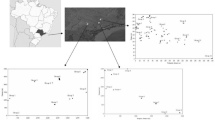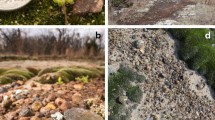Abstract
Patterns of mating and dispersal are key factors affecting the dynamics, viability and evolution of plant populations. Changes in mating system parameters can provide evidence of anthropogenic impacts on populations of rare plants. Tetratheca paynterae subsp. paynterae is a critically endangered perennial shrub confined to a single ironstone range in Western Australia. Mining of the range removed 25% of plants in 2004 and further plants may be removed if the viability of the remaining populations is not compromised. To provide baseline genetic data for monitoring mining impacts, we characterised the mating system and pollen dispersal over two seasons in T. paynterae subsp. paynterae and compared mating system parameters with two other ironstone endemics, T. paynterae subsp. cremnobata and T. aphylla subsp. aphylla that were not impacted by mining. T. paynterae subsp. paynterae was the only taxon showing evidence of inbreeding (t m = 0.89), although hand pollination revealed pre-zygotic self-incompatibility limits the production of seed from self-pollen. In a year of lower fruit set (2005), the estimate of correlated paternity increased from 20 to 35%. Direct estimates of realised pollen dispersal, made by paternity assignment in two small populations where all adult plants were genotyped, revealed a leptokurtic distribution with 30% of pollen dispersed less than 3 m and 90% less than 15 m. Restricted pollen dispersal maintains the strong genetic structuring of the adult populations in succeeding generations. As a consequence of preferential outcrossing, any reduction in effective population size, flowering plant density and/or the abundance and activity of pollinators may impact negatively on population viability through reduced seed set, increased inbreeding and increased correlated paternity.





Similar content being viewed by others
References
Alexander MP, Ganeshan S (1989) An improved method for in vitro germination of recalcitrant pollen. Biotechnic Histochem 64:225–227
Alford JJ (1995) Two new species of Tetratheca (Tremandraceae), from the Coolgardie and Austin Botanical Districts, Western Australia. Nuytsia 10:143–149
Bond WJ (1994) Do mutualisms matter? Assessing the impact of pollinator and disperser disruption on plant extinction. Phil Trans R Soc Lond B 344:83–90
Buchmann SL, Cane JH (1989) Bees assess pollen returns while sonicating Solanum flowers. Oecologia 81:289–294
Butcher PA, Krauss SL (2009) Development of microsatellites from the rare ironstone endemic, Tetratheca paynterae subsp. paynterae and cross species amplification. Mol Ecol Res 9:386–389
Butcher PA, Moran GF, Perkins HD (1998) RFLP diversity in the nuclear genome of Acacia mangium. Heredity 81:205–213
Butcher PA, McNee SA, Krauss SL (2009) Genetic impacts of habitat loss on the rare ironstone endemic, Tetratheca paynterae subsp. paynterae. Conserv Genet 10:1735–1746
Butcher R (2007) New taxa of ‘leafless’ Tetratheca (Elaeocarpaceae, formerly Tremandraceae) from Western Australia. Aust Syst Bot 20:139–160
Butcher R, Byrne M, Crayn DM (2007) Evidence for convergent evolution among phylogenetically distant rare species of Tetratheca (Elaeocarpaceae, formerly Tremandraceae) from Western Australia. Aust Syst Bot 20:126–138
Crawford TJ (1984) The estimation of neighbourhood parameters for plant populations. Heredity 52:273–283
de Nettancourt D (1997) Incompatibility in angiosperms. Sex Plant Reprod 10:185–199
Driscoll C (2003) Pollination ecology of Tetratheca juncea (Tremandaceae): finding the pollinators. Cunninghamia 8:133–140
Eckert CG, Kalisz S, Geber MA, Sargent R, Elle E, Cheptou P-O, Goodwillie C, Johnston MO, Kelly JK, Moeller DA, Porcher E, Ree RH, Vallejo-Marin M, Winn AA (2009) Plant mating systems in a changing world. TREE 25:35–43
Ellstrand NC, Elam DR (1993) Population genetic consequences of small population size: implications for plant conservation. Ann Rev Ecol Syst 24:217–242
Gibson N, Coates DJ, Thiele KR (2007) Taxonomic research and the conservation status of flora in the Yilgarn banded iron formation ranges. Nuytsia 17:1–12
Gibson N, Yates CJ, Dillon R (2010) Plant communities of the ironstone ranges of South Western Australia: hotspots for plant diversity and mineral deposits. Biodivers Conserv 19:3951–3962
Goodwillie C, Kalisz S, Eckert CG (2005) The evolutionary enigma of mixed mating systems in plants: occurrence, theoretical explanations and empirical evidence. Annu Rev Ecol Syst 36:47–79
Gross CL, Mackay D (1998) Honeybees reduce fitness in the pioneer shrub Melastoma affine (Melastomataceae). Biol Conserv 86:169–178
Gross CL, Bartier FV, Mulligan DR (2003) Floral structure, breeding system and fruit set in the threatened sub shrup Tetratheca juncea Smith (Tremandaceae). Ann Bot 92:771–777
Harder LD, Barclay RMR (1994) The functional significance of poricidal anthers and buzz pollination: controlled pollen removal from Dodecatheon. Funct Ecol 8:509–517
Hopper SD (2009) OCBIL theory: towards an integrated understanding of the evolution, ecology and conservation of biodiversity on old, climatically buffered, infertile landscapes. Plant Soil 322:49–86
Ivey CT, Wyatt R (1999) Family outcrossing rates and neighbourhood floral density in natural populations of swamp milkweed (Asclepias incarnata); potential statistical artifacts. Theor App Genet 98:1063–1071
Jain SK (1976) The evolution of inbreeding in plants. Annu Rev Ecol Syst 7:469–495
Jarne P, Charlesworth D (1993) The evolution of selfing rate in functionally hermaphrodite plants and animals. Annu Rev Ecol Syst 24:441–466
Kalinowski ST, Taper ML, Marshall TC (2007) Revising how the computer program CERVUS accommodates genotyping error increases success in paternity assignment. Mol Ecol 16:1099–1106
King MJ, Buchmann SL (1996) Sonication dispensing of pollen from Solanum laciniatum flowers. Funct Ecol 10:449–456
Knight TM, Steets JA, Vamosi JC et al (2005) Pollen limitation of plant reproduction: pattern and process. Annu Rev Ecol Evol Syst 36:467–497
Lascalles DF (2007) Black smokers and density currents: a uniformitarian model for the genesis of banded iron-formations. Ore Geol Rev 32:281–411
Lloyd DG (1965) Evolution of self-compatibility and racial differentiation in Leavenworthia (Crucifereae). Contrib Gray Herb Harv Univ 195:3–134
Lloyd DG (1992) Self- and cross-fertilization in plants. II. The selection of self-fertilization. Int J Plant Sci 153:370–380
Marshall TC, Slate J, Kruuk LEB, Pemberton JM (1998) Statistical confidence for likelihood-based paternity inference in natural populations. Mol Ecol 7:639–655
Mathews ML, Endress PK (2002) Comparative floral structure and systematics in Oxalidales (Oxalidaceae, Connaraceae, Brunelliaceae, Cephalotaceae, Cunoniaceae, Elaeocarpaceae, Tremandraceae). Bot J Linn Soc 140:321–381
Mucina L, Wardell-Johnson GW (2011) Landscape age and soil fertility, climatic stability, and fire regime predicability: beyond the OCBIL framework. Plant Soil. doi:10.1007/s11104-011-0734-x
Murashige T, Skoog F (1962) A revised medium for rapid growth and bio-assays with tobacco callus culture. Physiol Plant 15:473–497
Ritland K (1989) Correlated matings in the partial selfer Mimulus guttatus. Evolution 43:848–859
Ritland K (2002) Extensions of models for the estimation of mating systems using n independent loci. Heredity 88:221–228
Schoen DJ (1982) The breeding system of Gilia archilleifolia: variation in floral characteristics and outcrossing rate. Evolution 36:352–360
Schwartz MK, Luikart G, Waples RS (2007) Genetic monitoring as a promising tool for conservation and management. TREE 22:25–33
Sharifi MR, Gibson AC, Rundel PW (1997) Surface dust impacts on gas exchange in Mojave Desert shrubs. J Appl Ecol 34:837–846
Shaw DV, Kahler AL, Allard RW (1980) A multilocus estimator of mating system parameters in plant populations. Proc Natl Acad Sci USA 78:1298–1302
Underwood AJ (1994) On beyond BACI: sampling designs that might reliably detect environmental disturbances. Ecol Appl 4:3–15
Uyenoyama MK (1986) Inbreeding and the cost of meiosis: the evolution of selfing in populations practicing biparental inbreeding. Evolution 40:388–404
Vaknin Y, Gan-Mor S, Bechar A, Ronen B, Eisikowitch D (2000) The role of electrostatic forces in pollination. Plant Syst Evol 222:133–142
Willi Y, Van Buskirk J, Hoffmann AA (2006) Limits to the adaptive potential of small populations. Ann Rev Ecol Evol Syst 37:433–458
Wyatt R (1986) Ecology and evolution of self-pollination in Arenaria uniflora (Caryophyllaceae). J Ecol 74:403–418
Acknowledgments
Funding from Portman Iron Ore Pty Ltd and access to unpublished technical reports is gratefully acknowledged. We also acknowledge support provided by Piers Goodman, James Hesford and Rob Howard from Portman Iron Ore Pty Ltd, field assistance provided by Janet Anthony from Kings Park and Botanic Garden (BGPA), Geoff Cockerton, Shapelle McNee and Gemma McLean from Western Botanical, Colin Yates and Rebecca Dillon from the Department of Environment and Conservation and technical advice on pollination provided by Patrick Courtney from BGPA. Constructive comments from two anonymous referees are also acknowledged. Seed was collected under permit No. SW010813 issued under the Western Australian Wildlife Conservation Act 1950.
Author information
Authors and Affiliations
Corresponding author
Rights and permissions
About this article
Cite this article
Butcher, P.A., Bradbury, D. & Krauss, S.L. Limited pollen-mediated dispersal and partial self-incompatibility in the rare ironstone endemic Tetratheca paynterae subsp. paynterae increase the risks associated with habitat loss. Conserv Genet 12, 1603–1618 (2011). https://doi.org/10.1007/s10592-011-0258-1
Received:
Accepted:
Published:
Issue Date:
DOI: https://doi.org/10.1007/s10592-011-0258-1




